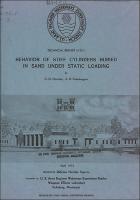Please use this identifier to cite or link to this item:
https://hdl.handle.net/11681/6815| Title: | Behavior of stiff cylinders buried in sand under static loading |
| Authors: | United States. Defense Nuclear Agency Norman, C. Dean Prendergast, J. D. (James D.) |
| Keywords: | Buried cylinders Sands Static loads |
| Publisher: | Weapons Effects Laboratory (U.S.) Engineer Research and Development Center (U.S.) |
| Series/Report no.: | Technical report (U.S. Army Engineer Waterways Experiment Station) ; N-73-1. |
| Description: | Technical report Abstract: The objective of this investigation was to study experimentally the elastic behavior of horizontally oriented, stiff cylinders buried at shallow depths in dense, dry sand and subjected to static surface overpressures. Static tests were conducted on nine different cylinders in the u. S. Army Engineer Waterways Experiment Station 1 s Small (4-foot-diruneter) Blast Load Generator (SBLG). The cylinders were fabricated from steel mechanical tubing having a 6-inch outside diameter and a specially isolated 12-inch-long test section. The nine test specimens comprised three groups of cylinders with wall thicknesses of 1/8, 1/4, and 3/8 inch that corresponded to stiffnesses (EI.,T/R3-) of 170-, r,644, and- 5 ,926 psi, respectively. In order to study the effects of burial depth, the first, second, and third cylinders of each group were tested at depths of 3, 6, and 9 inches, respectively. A total of 14 static tests were conducted, 9 on virgin soil samples and 5 on samples that had been previously loaded. The peak surface overpressure attained for all tests was approximately 1,000 psi. Measurements were made of cylinder hoop strain, vertical diameter change, soil stress, and surface overpressure. The test results indicated that cylinder stiffness significantly affected the overall response of the soil-structure system normalized moment (M/PR2) data obtained from these tests were determined to be much greater than such values for less stiff cylinders. However, the maximum values of the normalized moments from the test data were in close agreement with the analytically predicted upper-bound values for a rigid cylinder. The experimental information for the 1/4- and 3/8-inchthick cylinders was used to provide data in the low normalized pressure (PR3/EI) region, for which very little data previously existed. For the range of cylinder stiffnesses tested, normalized thrust values (T/PR) indicated that both active and passive arching occurred and were dependent on cylinder stiffness. A description of the properties of the steel used in fabricating the test cylinders is given in Appendix A, and a description of the confines soil properties is given in Appendix B. |
| Rights: | Approved for public release; distribution is unlimited. |
| URI: | http://hdl.handle.net/11681/6815 |
| Appears in Collections: | Technical Report |
Files in This Item:
| File | Description | Size | Format | |
|---|---|---|---|---|
| TR-N-73-1.pdf | 4.11 MB | Adobe PDF |  View/Open |